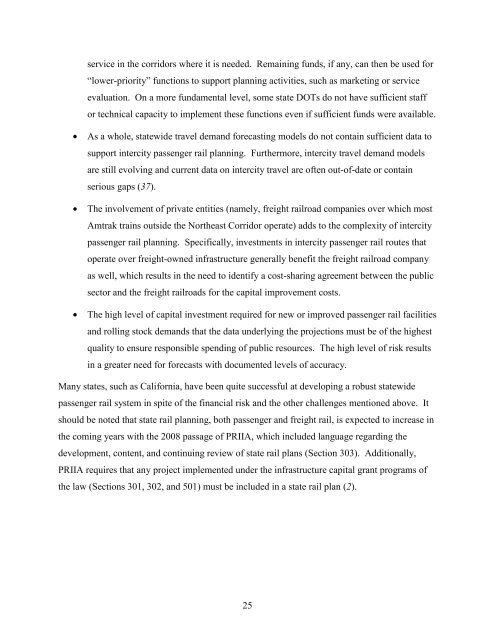Measuring the Benefits of Intercity Passenger Rail: A Study
Measuring the Benefits of Intercity Passenger Rail: A Study
Measuring the Benefits of Intercity Passenger Rail: A Study
You also want an ePaper? Increase the reach of your titles
YUMPU automatically turns print PDFs into web optimized ePapers that Google loves.
service in <strong>the</strong> corridors where it is needed. Remaining funds, if any, can <strong>the</strong>n be used for<br />
“lower-priority” functions to support planning activities, such as marketing or service<br />
evaluation. On a more fundamental level, some state DOTs do not have sufficient staff<br />
or technical capacity to implement <strong>the</strong>se functions even if sufficient funds were available.<br />
• As a whole, statewide travel demand forecasting models do not contain sufficient data to<br />
support intercity passenger rail planning. Fur<strong>the</strong>rmore, intercity travel demand models<br />
are still evolving and current data on intercity travel are <strong>of</strong>ten out-<strong>of</strong>-date or contain<br />
serious gaps (37).<br />
• The involvement <strong>of</strong> private entities (namely, freight railroad companies over which most<br />
Amtrak trains outside <strong>the</strong> Nor<strong>the</strong>ast Corridor operate) adds to <strong>the</strong> complexity <strong>of</strong> intercity<br />
passenger rail planning. Specifically, investments in intercity passenger rail routes that<br />
operate over freight-owned infrastructure generally benefit <strong>the</strong> freight railroad company<br />
as well, which results in <strong>the</strong> need to identify a cost-sharing agreement between <strong>the</strong> public<br />
sector and <strong>the</strong> freight railroads for <strong>the</strong> capital improvement costs.<br />
• The high level <strong>of</strong> capital investment required for new or improved passenger rail facilities<br />
and rolling stock demands that <strong>the</strong> data underlying <strong>the</strong> projections must be <strong>of</strong> <strong>the</strong> highest<br />
quality to ensure responsible spending <strong>of</strong> public resources. The high level <strong>of</strong> risk results<br />
in a greater need for forecasts with documented levels <strong>of</strong> accuracy.<br />
Many states, such as California, have been quite successful at developing a robust statewide<br />
passenger rail system in spite <strong>of</strong> <strong>the</strong> financial risk and <strong>the</strong> o<strong>the</strong>r challenges mentioned above. It<br />
should be noted that state rail planning, both passenger and freight rail, is expected to increase in<br />
<strong>the</strong> coming years with <strong>the</strong> 2008 passage <strong>of</strong> PRIIA, which included language regarding <strong>the</strong><br />
development, content, and continuing review <strong>of</strong> state rail plans (Section 303). Additionally,<br />
PRIIA requires that any project implemented under <strong>the</strong> infrastructure capital grant programs <strong>of</strong><br />
<strong>the</strong> law (Sections 301, 302, and 501) must be included in a state rail plan (2).<br />
25
















